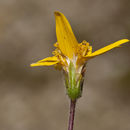Description
provided by eFloras
Plants 8–35 cm. Stems (branches from rhizomes) simple. Leaves 2–4 pairs (basal often persistent on sterile rosettes), mostly cauline; petiolate (at least basal) or sessile; blades oblanceolate to spatulate, 2–7 × 0.5–2.5 cm, margins usually entire, sometimes denticulate, rarely dentate, apices usually acute, sometimes obtuse, faces sparsely puberulent, moderately pubescent distally, stipitate-glandular. Heads 1–3(–5). Involucres turbinate-campanulate. Phyllaries 9–15, linear-oblong to narrowly lanceolate. Ray florets 6–10; corollas yellow. Disc florets: corollas yellow; anthers yellow. Cypselae brown, 4–7 mm, densely hirsute (not stipitate-glandular); pappi white, bristles barbellate . 2n = 38, 76.
- license
- cc-by-nc-sa-3.0
- copyright
- Missouri Botanical Garden, 4344 Shaw Boulevard, St. Louis, MO, 63110 USA
Comprehensive Description
provided by North American Flora
Arnica rydbergii Greene, Pittonia 4: 36. 1899
Arnica caespitosa A. Nels. Bot. Gaz. 30: 203. 1900. Arnica tenuis Rydb. Bull. Torrey Club 28: 20. Ja 1901. Arnica aurantiaca Greene, Torreya 1: 42. Ap 1901. ^Arnica lasiosperma Greene, Leaflets 2: 48. 1910.
Rootstock short, branched; stems erect, 1-3 dm. high, sparingly villous below, more
densely so on the peduncles, with crisp hairs; leaves of the offsets and basal leaves oblanceolate,
4-7 cm. long, obtuse or acute, 3-5 ribbed, entire, tapering below into a short petiole, ciliolate on
the veins; stem-leaves mostly 3 pairs, sessile, the lower oblanceolate, the upper lanceolate,
sometimes few-toothed, more pubescent; heads 1-3; involucre densely villous at the base,
otherwise sparingly so and lightly glandular-puberulent, 10-12 mm. high and about as broad;
bracts 10-12, lance-linear, acute; ray-flowers 8-10, the ligules orange, about 15 mm. long,
3-5 mm. wide, minutely 3-toothed or subentire, pubescent on the lower surface; achenes 5-6
mm. long, hirsute; pappus-bristles white, 6-8 mm. long, barbellate. A. tenuis represents a
depauperate slender form with entire leaves.
Type locality: Little Belt Mountains, Montana.
Distribution: Alberta and British Columbia to Colorado and Oregon.
- bibliographic citation
- Per Axel Rydberg. 1927. (CARDUALES); CARDUACEAE; LIABEAE, NEUROLAENEAE, SENECIONEAE (pars). North American flora. vol 34(4). New York Botanical Garden, New York, NY
Arnica rydbergii: Brief Summary
provided by wikipedia EN
Arnica rydbergii is a North American species of flowering plant in the family Asteraceae, known by the common name Rydberg's arnica or subalpine arnica or subalpine leopardbane. It is native to western Canada (Alberta, British Columbia), and the western United States (Alaska, Washington, Oregon, Utah, Idaho, Montana, Utah, Wyoming, Colorado, South Dakota).
Arnica rydbergii is an herb up to 35 cm (14 inches) tall. Flower heads are yellow, with both ray florets and disc florets. It grows in alpine meadows and rocky slopes at high altitudes in mountainous areas.
The species is named for Swedish-American botanist Per Axel Rydberg, 1860–1931.
- license
- cc-by-sa-3.0
- copyright
- Wikipedia authors and editors

